Next week, the happiest day of the year will be upon us, World Smile Day! I am often asked which my favourite species are to work with at the park. It must be said, the little guys never fail to put a smile on my face every day. With the famous saying “good things come in small packages”, it couldn’t be more fitting to describing our smallest group of primates; the Callitrichidae family. This term refers to marmosets and tamarins, some of the smallest monkeys on the planet.
There are 22 different species of marmoset in the world and 18 species of tamarin; here at Wingham Wildlife Park, we are home to six of these. I’d like to take this month’s blog to introduce you to them all.
Marmosets vs Tamarins
So, what is the difference between these two? Well both share home ranges across the tropical rainforests of Central and South America. However, the tamarins are a wee bit bigger. They stand at 17inches long (nose to tip of tail) with the mini marmosets at just 15 inches; the pygmy marmoset however scores at just 6 inches long making him the record holder of ‘world’s smallest monkey’.
As well as being smaller physically, marmosets will also live in smaller groups of up to 15. Whereas the tamarin will live in bigger communities of up to 40 individuals. Another difference between them is their teeth. Marmosets will have large incisors, the same length as their canines. They’re perfect for chewing holes in wood and bark to get to tree sap. Whereas the tamarins have shorter incisors and longer canines perfect for biting and chewing insects and fruit.
Common Marmosets
We have a family group of 5 common marmosets. They consist of mum Sugar, dad Spice and offspring Nutmeg, Cinnamon and Ginger. These little guys are easily spotted by the large white tufts of hair either side of the head, looking like very big ears! They are grey in colour speckled with browns and yellows and have a banded tail with a white forehead.
The common marmoset is native only to east-central Brazil. However, if you recall back to my blog about my travels to South America, you may remember that the marmosets have been introduced to other areas and inhabit the city of Rio de Janeiro. This means that I pretty much saw them everywhere! As this species is quite abundant, they are not classed as at risk just yet. Nevertheless, their habitat is declining at an alarming rate due to human use and cultivation. As they are pretty cute, they are often victim to the pet trade. Plus, they are the most commonly used non-human primate in experimental medical studies.
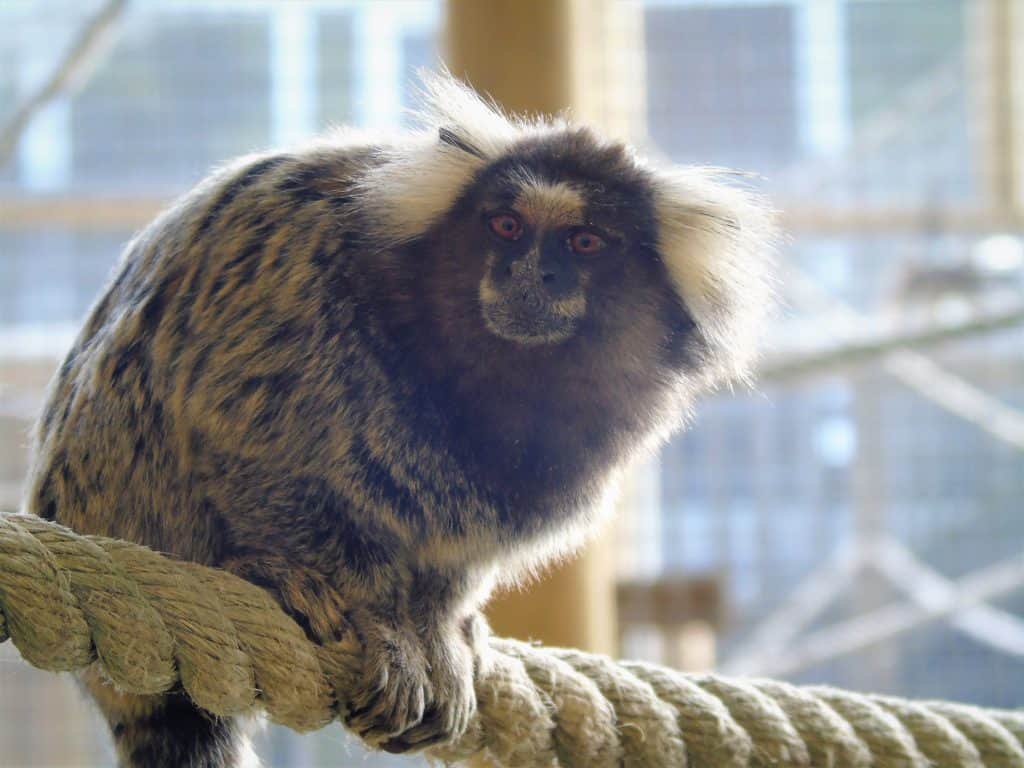
Our family group can often be found soaking up the rays in their new outside area near the lemur walkthrough. Their personalities seemed to have completely changed since having the bigger space. Before, they used to be quite aggressive towards keepers, particularly over food and would often take a swipe at faces! But since having a whole new area to explore, they are much gentler and friendlier. I have even managed to target train three of them!
Goeldi Marmosets
Although technically part of the Callitrichidae family, these shaggy black pocket-sized primates are actually the only species in their genus, Callimico. There are few differences which set them apart from tamarins and marmosets.
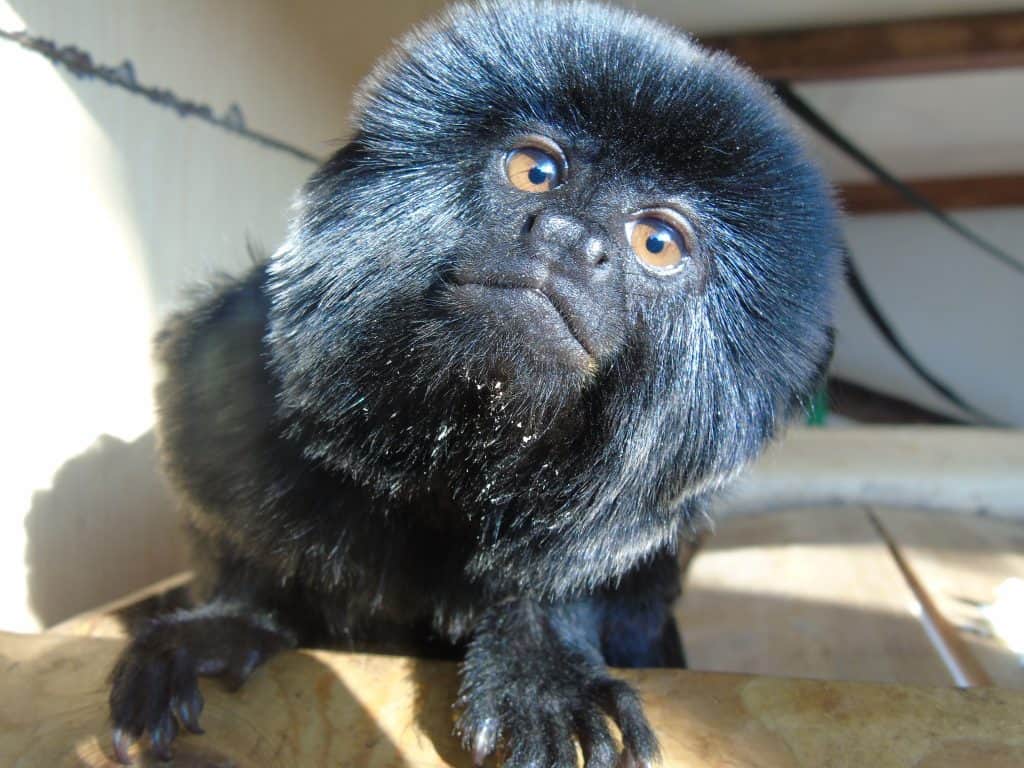
They have a much larger range than the others. They are also the only monkey known to eat mushrooms as a substantial part of their diet. Although, I don’t think our six Goeldi’s got the memo as they always leave their mushrooms! Goeldi’s tend to give birth to a single baby. Unlike the other species who give birth to twins or triplets. The father also has a much less hands-on approach to that of marmoset and tamarin dads.
Measuring a puny 13 inches long, Goeldi’s can leap an impressive 13 feet horizontally without losing height. They can leap from one tree to another, turn in flight and catch their prey of insects. In the rainforests, they will primarily feed on fruit, insects and small vertebrates. However, here, we feed them a variety of vegetables, mealworms, locusts and cockroaches as well as egg and marmoset gum.
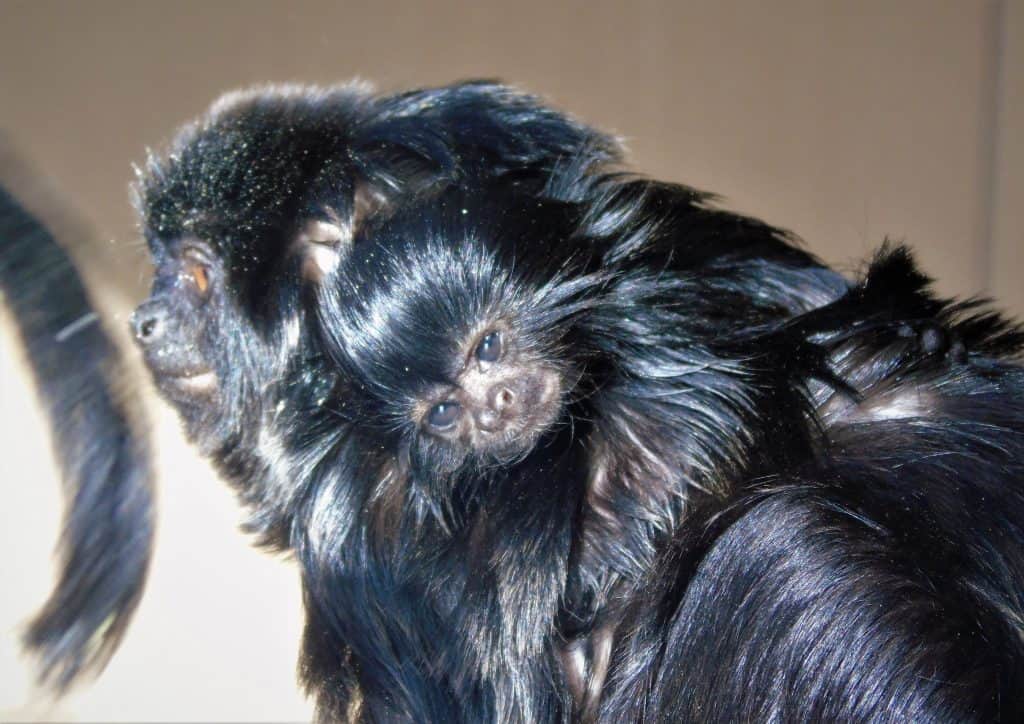
If you have been to the park, you may have noticed we have two groups of Goeldi’s monkey. One group of four upstairs in the chimp house and a pair living at the top of the park with the squirrel monkeys.
These used to live as a harmonious group all together. That is until our oldest female, Maggy suddenly produced a very unexpected offspring. These had not bred since being at the park, so it was a bit of a shock to find a teeny tiny Goeldi on her back one morning.
Sticking with the theme of The Simpson’s names (Maggy, Bart and Lisa), the youngster was quickly christened Spiderpig (unfortunately this was to Markus’s disapproval) and soon turned into a shouty screaming individual like the rest of his family; Goeldi’s vocalise in high pitched cries that can be heard up to 100m away.
As Spiderpig grew stronger, his parents and older brother started to turn on the two younger females of the group, Ebony and Marge and ejected them from the family. This would occur in the wild as they encourage the older offspring to move off and find their own territory. Hence why the two girls now hang out in the company of Frodo and Samwise the squirrel monkeys.
Pygmy Marmosets
Our little Harry only weighs in at around 100grams and is the world’s smallest primate. The pygmy marmoset is sometimes called the Finger Monkey as the youngsters are small enough to cling onto your little finger. Because of this, pygmy marmosets are often captured and sold into the pet trade. Even though it is illegal to import or export this species out of South America.
Different states of the USA have different legislations around keeping them as pets. Sadly, they can still be bought for up to $4000. However, their diet and habitat need to be replicated as much as possible. Therefore, it can be extremely difficult to keep a marmoset healthy in your home.

A perfect adaptation of arboreal living is the ability to rotate his head 180 degrees. Plus, they have sharp claw like nails to grip onto tree bark and branches. They can leap up to 5m between trees. Like the common marmoset they have teeth perfectly designed for gouging trees in search of tree sap.
Harry is a very shy character. If he feels scared or tries to be intimidating, he will do what the keepers have named “the bum dance”. He will puff his hair up on end, turn his back to you, lift the tail and strut around showing you his genitals. Very scary!
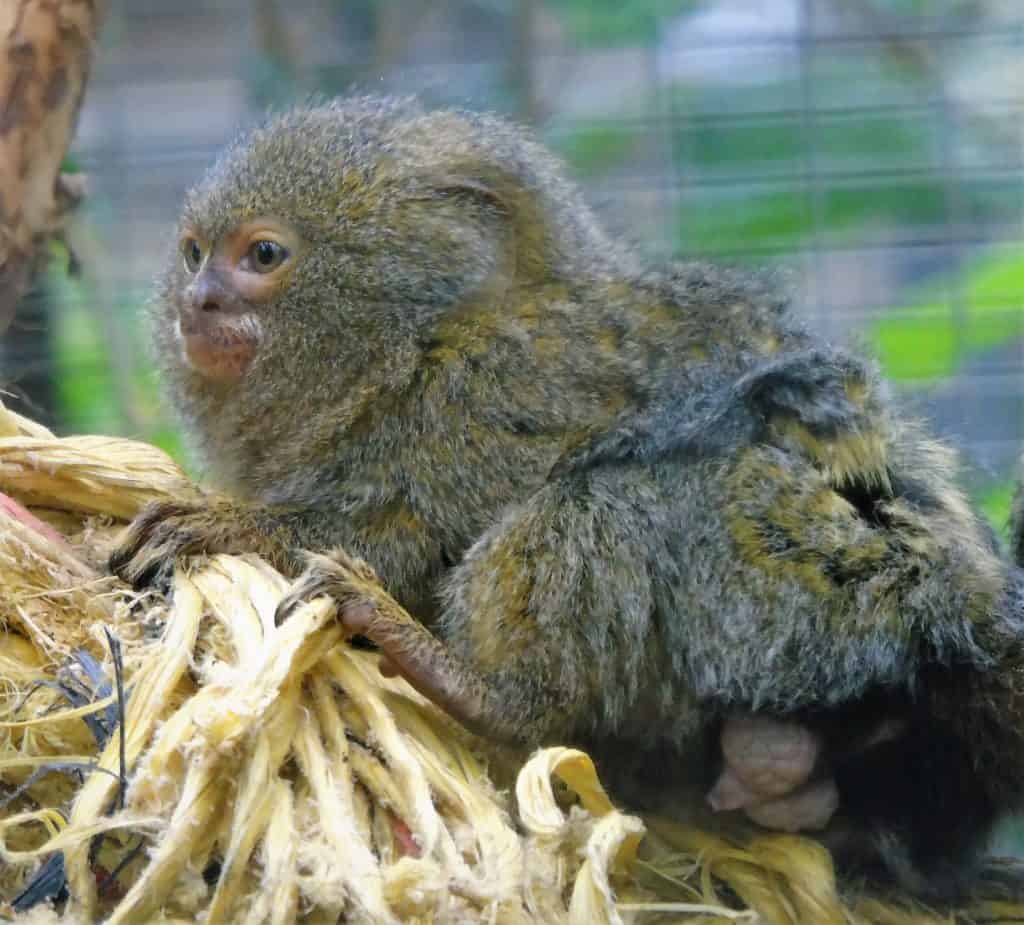
Harry arrived at Wingham from Sandwich Wildlife Park about 18 months ago with his brother Ron. Together they took up residence in the tropical house. Since the new enclosures were built, Harry and Ron moved in with Edgar our Emperor Tamarin next to the chimp house. Unfortunately, we lost Ron a few months back, but Harry is perfectly happy living with Edgar. Who knows, hopefully in the future, we may be able to find him a Hermione or Ginny!
Cotton Top Tamarins
Weighing in at just 400grams each we have some of the most stylish monkeys, Tina and Yoto our breeding pair of Cotton Top Tamarins. These guys are easily spotted by their long sagittal crest of white hair from their forehead, flowing over their shoulders. In fact, Tina was named after Tina Turner to complement the epic hairdo.
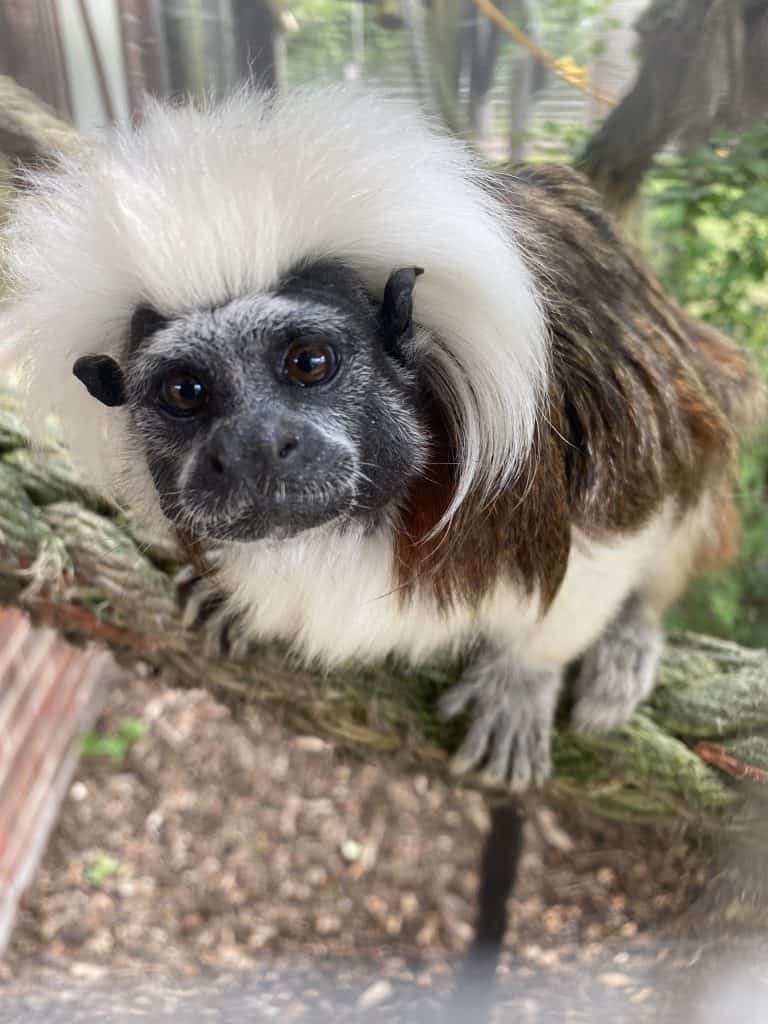
In the wild, you will be extremely lucky to see these guys as they are exclusive to Columbia. Plus, 98% of their habitat has been destroyed leaving the Cotton Top listed as critically endangered. It is one of the rarest primates in the world, with only 6,000 individuals left in the wild.
Although Tina and Yoto have not reproduced yet. However, if and when they do, we would expect to see Yoto being a very hands-on father. This is because the males take a primary role in the caregiving of infants. So much so that they can lose up to 10% of their body weight in doing so. This weight loss is caused by the inability to forage for food as effectively as without a baby to lug around. This is the opposite of the dominant females who, on the lead up to ovulation, increases her food intake and gains weight. Plus, she relinquishes much of her baby-carry duties. The best way to tell the difference between our pair, as males and females are the same size, is to look at their faces…Yoto has a very distinctive frown and will flick his tongue angrily at you if you stare for too long!
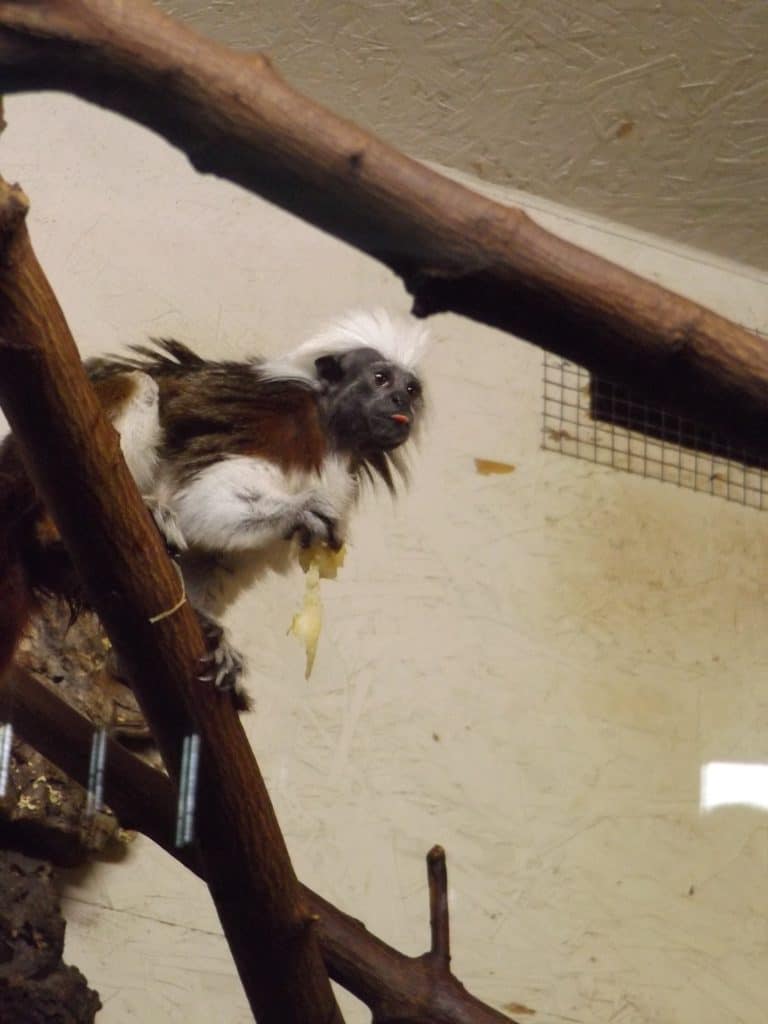
Red Handed Tamarins
Luke and Leia are our brother and sister pair of Red-Handed tamarins. They’re named so after their beautifully golden coloured hands and feet.
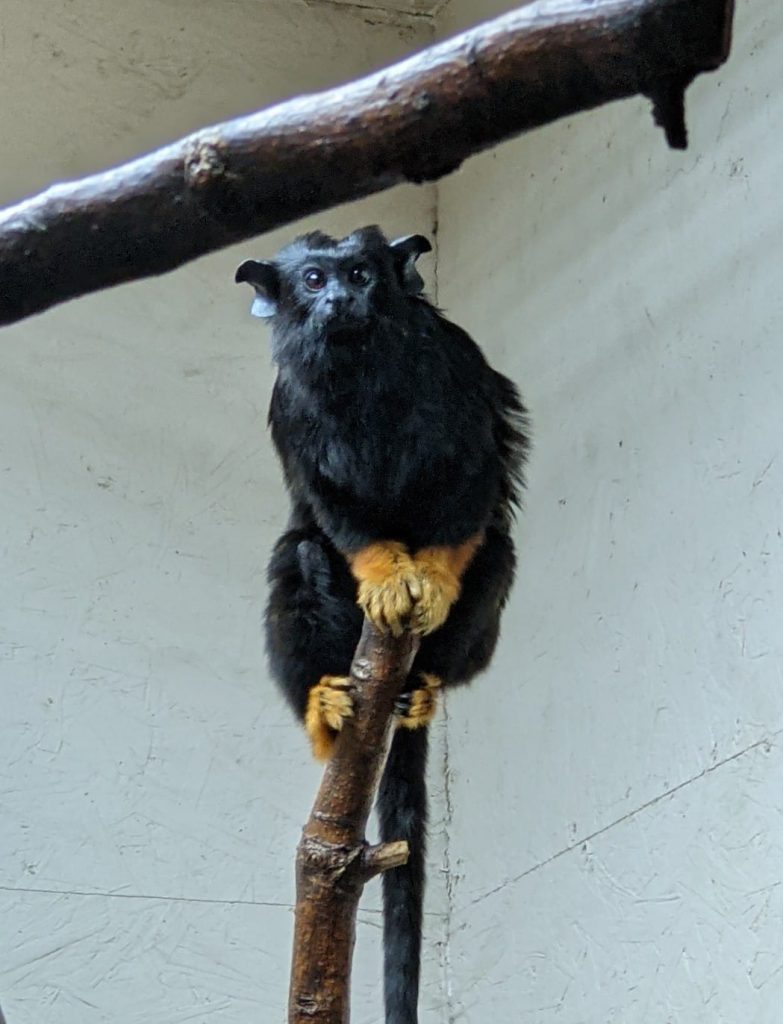
These are our shyest pair of primates. Despite having had access to their large outdoor area for the same amount of time as the other callitrichidae, they don’t often venture outside. Perhaps they are too nervous to make the trip through the long tunnels? They are starting to get a bit braver and have been seen outside occasionally in nice weather though.
Measuring at 44 cm nose to tail and weighing up to 550 grams, they’re the biggest species of tamarin at WWP. Like most tamarins and marmosets, red-handeds have claws instead of nails on their fingers and toes (all except the big toe) making them perfectly adapted for life in the trees; being a quick and agile primate, they can jump distances of over 60ft even from a tree to the ground. While these little guys are not currently under threat, they do adopt a very defensive lifestyle. They will all rush to the aid of anyone who is threatened by predators such as birds of prey, snakes and small cats.
Emperor Tamarins
Having saved the best till last, a firm favourite with all his keepers and never fails to make anyone smile, we have the most sophisticated gentleman in the park, Edgar the Emperor Tamarin.
Found next to the chimp house, living with Harry, Edgar and his wonderful moustache will often greet you at the window. Often with an adorably surprised look on his face. Not one to shy away from a ride on a keeper’s shoulder or back, Edgar is always pleased to see you. Especially if you’re bringing him sweet potato!

Living amongst the most humid regions of the Amazonian rainforests, groups of up to 18 Emperor tamarins will feast on flowers and fruit as well as tree sap, insects and even frogs! The dominant female will mate with multiple males in the group. This ensures the males are more likely to invest in the offspring as the possibility one of the babies will carry onto the next generation.
Fingers crossed we can find Edgar a girlfriend soon although I don’t think I could cope with the cuteness of baby Emperors with tiny moustaches <3

Hopefully learning a few fun facts about my favourite mini monkeys has put a smile of your faces in honour of World Smile Day 😊. Keep an eye out for them all on your next visit.


